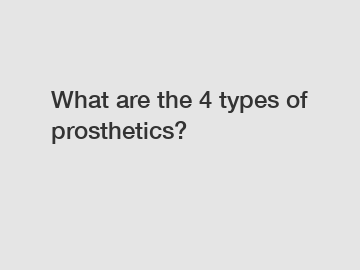What are the 4 types of prosthetics?
Prosthetics have come a long way in recent years, offering individuals who have lost a limb or multiple limbs the chance to regain mobility, independence, and confidence. There are four main types of prosthetics that are commonly used today, each offering unique benefits and limitations. In this blog post, we will explore these four types of prosthetics in detail, highlighting the features and considerations for each.
1. Mechanical Prosthetics: Mechanical prosthetics are one of the most traditional types of prosthetics, relying on basic mechanical components to mimic the function of a missing limb. These prosthetics are often made of durable materials such as plastic, metal, or carbon fiber, and are designed to withstand the rigors of daily use. Mechanical prosthetics are typically controlled by the user's own body movements, such as muscle contractions or joint movements, allowing for basic functionality such as gripping objects or walking.
While mechanical prosthetics can be an effective option for some individuals, they do have limitations in terms of dexterity and range of motion. These prosthetics are often heavier and bulkier than other types, making them more cumbersome to wear and use. Additionally, the lack of advanced technology in mechanical prosthetics can limit their functionality in certain tasks, such as fine motor skills or complex movements.

2. Myoelectric Prosthetics: Myoelectric prosthetics are a more advanced type of prosthetic that utilizes electronic sensors to detect and interpret muscle signals from the user's residual limb. These sensors can detect even subtle muscle movements, allowing for more precise control over the prosthetic limb. Myoelectric prosthetics are often equipped with motors and batteries that power the movement of the limb, providing a more natural and fluid range of motion.
One of the key benefits of myoelectric prosthetics is their ability to provide a more lifelike appearance and functionality compared to mechanical prosthetics. Users can perform a wider range of tasks with greater ease and precision, such as grasping small objects or typing on a keyboard. Myoelectric prosthetics can also be customized to fit the individual's specific needs and preferences, enhancing comfort and usability.
3. Microprocessor-Controlled Prosthetics: Microprocessor-controlled prosthetics represent the cutting edge of prosthetic technology, incorporating advanced microprocessors and sensors to provide intelligent control and feedback. These prosthetics can adapt to the user's movements and adjust their function in real time, offering a level of versatility and responsiveness that was previously unheard of. Microprocessor-controlled prosthetics are often equipped with multiple pre-programmed modes for different activities, such as walking, running, or climbing stairs.
The main advantage of microprocessor-controlled prosthetics is their ability to adapt to the user's changing needs and environment. These prosthetics can anticipate and respond to subtle changes in terrain or movement, providing a more seamless and natural experience for the user. Additionally, the advanced technology in microprocessor-controlled prosthetics can improve energy efficiency and reduce strain on the user's body, leading to better long-term outcomes.
4. 3D Printed Prosthetics: 3D printed prosthetics represent a revolutionary approach to prosthetic design and manufacturing, using cutting-edge 3D printing technology to create custom-fitted prosthetic devices. These prosthetics are often lighter, more durable, and more affordable than traditional prosthetics, making them an attractive option for many individuals. 3D printed prosthetics can be customized to match the user's unique anatomy, providing a comfortable and secure fit that enhances mobility and function.
One of the key advantages of 3D printed prosthetics is their rapid prototyping capabilities, allowing for quicker design iterations and adjustments. This can significantly reduce the time and cost of prosthetic production, making prosthetics more accessible to a wider range of users. Additionally, the flexibility of 3D printing allows for intricate and complex designs that can closely mimic the appearance and function of natural limbs.
In conclusion, the four types of prosthetics – mechanical, myoelectric, microprocessor-controlled, and 3D printed – offer a range of options for individuals in need of prosthetic limbs. Each type has its own unique features and considerations, and the best choice will depend on the individual's specific needs, preferences, and goals. With advancements in technology and materials, prosthetics continue to evolve and improve, providing users with greater mobility, independence, and quality of life. Whether you are considering a prosthetic for yourself or a loved one, it's important to consult with a qualified prosthetist to explore the options and find the best fit for your needs.
The company is the world’s best support boot for ankle, hand cover gloves, orthopedic walking boot for sprained ankle supplier. We are your one-stop shop for all needs. Our staff are highly-specialized and will help you find the product you need.

Comments